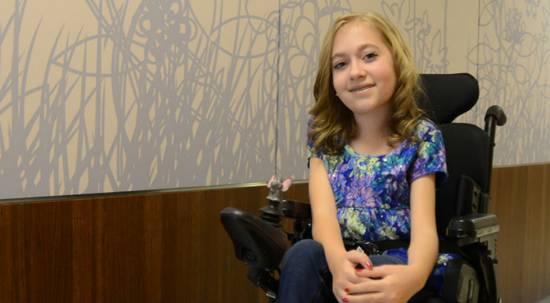Spinal Muscular Atrophy (SMA)

What Is Spinal Muscular Atrophy?
Spinal muscular atrophy, or SMA, is a rare genetic condition that affects the spinal cord’s motor nerve cells. The nerves affected by SMA don’t have enough of an essential protein called SMN, so they can’t carry signals from the brain to the muscles. Without those signals, muscles atrophy (weaken and decrease in mass). As a result, activities such as crawling, walking, breathing, and eating are difficult for children with SMA.
There are four types of SMA. There is a genetic difference between SMA types, but we typically classify types by age of onset and the severity of symptoms.
Also called infantile onset or Werdnig-Hoffmann disease, SMA I is the most severe form of the condition. Symptoms of SMA I usually develop by the time an infant is 6 months old. Most infants diagnosed with SMA I show severe muscle weakness and floppiness (also known as hypotonia). The muscle weakness also causes difficulty with swallowing and breathing. Without treatment, they have difficulty gaining strength and can’t sit on their own.
Sometimes called intermediate SMA, SMA II causes muscle weakness and hypotonia, but the problems are less severe than with SMA I. Babies and toddlers with type 2 spinal muscular atrophy learn to sit on their own, but without treatment, have trouble standing or walking. As they grow, some children lose the ability to stand and move freely. At that point, they need to use mobility devices, such as powered wheelchairs
Also called late-onset SMA (or Kugelberg-Welander disease), SMA III develops in children 18 months or older. Children who have SMA III walk on their own, but without treatment, might have trouble jumping or using stairs. The severity of this form varies widely. Some people aren’t diagnosed until adulthood. In those cases, the condition is sometimes called SMA IV, or adult-onset SMA.
SMA Type IV is very rare. It causes mild motor impairment (such as difficulty walking and a tendency to fatigue more easily) and usually begins in early adulthood.
SMA Signs and Symptoms
The signs of spinal muscular atrophy differ depending on the type. The most severe form of SMA usually affects essential functions important during your infant’s first six months of life.
Less severe forms of SMA often have milder symptoms that don’t develop until later in life. Even in milder cases, the disease gets worse over time (it’s progressive)—but not to the same degree as with severe cases.
If your infant has SMA, you might look for signs such as:
- Delays in the development of larger movements (gross motor skills)—or loss of skills already mastered
- Breathing problems
- Trouble feeding
- Limp or floppy muscles (hypotonia)
- Poor head control
- Lack of movement
- Muscle weakness that grows worse
- Difficulty gaining weight
If your child has SMA, you might look for signs such as:
- Delays in gross motor development, such as walking—or the loss of skills already mastered
- Frequent respiratory infections that get worse with each infection
- Nasal-sounding speech
- Posture that gets worse over time
- A curvature of the spine (scoliosis) that gets worse over time
What Causes Spinal Muscular Atrophy?
Spinal muscular atrophy is a hereditary condition that affects both males and females. SMA is caused by a change (mutation) in the survival motor neuron 1 gene (SMN1 gene), which, as its name suggests, is necessary for the survival and proper functioning of motor neurons, which are essential for controlling muscle movements. Two mutations are necessary to cause SMA.
Parents of children who have SMA are usually carriers. That means one copy of their SMN1 gene has a mutation, while the other is normal. If both parents are carriers, there is a one in four chance that a child will have SMA. Carriers don’t show symptoms of SMA, and usually have no history of the condition in their family.
In most cases, both parents of a child who has SMA are carriers. In a small number of cases, SMA develops from a new mutation in the formation of either the egg or the sperm. Roughly one in 50 people are SMA carriers.
SMA Diagnosis
If your child is suspected of having spinal muscular atrophy, a healthcare professional might use the following tests and examinations to make a diagnosis:
- Genetic testing: This blood test looks for changes (mutations) in the SMN1 gene responsible for SMA. Genetic testing is currently the best way to confirm a diagnosis of SMA.
- Physical exam: The physical exam tests gross motor abilities and assesses reflexes and overall development.
- Electromyography Testing (EMG): An EMG involves inserting a very thin needle (electrode) into the muscle. (Although used frequently in the past to diagnose SMA, this test has largely been replaced by genetic testing.)
- Muscle biopsy test: Doctors remove a small tissue sample and examine it under a microscope, looking for signs of muscle breakdown. (Although used frequently in the past to diagnose SMA, this test has largely been replaced by genetic testing.)
With improved newborn screening for SMA, which is now available in all 50 states, SMA is being detected much earlier than it was before screening started—sometimes even before the very first symptom of SMA has developed. Early diagnosis and initiation of treatment has been shown to improve patient outcomes.
Although there is no cure for SMA, there are currently 3 FDA-approved therapies to help reduce the symptoms in patients with SMA:
- Spinraza (nusinersen): a medication given by spinal tap (also known as a lumbar puncture or LP) every 4 months once on maintenance scheduling. Nusinersen works by helping the body make more of its own SMN protein. This medication is available to SMA patients of all ages.
- Evrysdi (risdiplam): a medication given every day by mouth. Evrysdi also works by helping the body make more of its own SMN protein. This medication is available to SMA patients of all ages.
- Zolgensma (onasemnogene abeparvovec): a one-time gene therapy given by intravenous (IV) infusion. This medication works by providing the motor neurons with a new, healthy SMN1 gene, which allows the body to produce functional SMN protein. This medication is currently only available to children before their 2nd birthday.
Our Gillette team actively prescribes each of these medications for our patients who are interested in treatment. Once Gillette Children's specialists diagnose your child, your family will get a customized treatment plan based on what is best for your child.
SMA Care at Gillette Children's
If your child has spinal muscular atrophy, you can rely on specialized treatment from Gillette, one of the region’s top neuromuscular programs. CureSMA, a national advocacy group for people affected by SMA, endorses Gillette as a preferred treatment center. Our combination of research and clinical services supports your family’s journey in living with and managing SMA.
Regular checkups are essential for slowing the progression of symptoms and avoiding secondary complications. As children reach adulthood, we provide age-appropriate SMA care through Gillette Adult Services for teens (16 and older) and adults.
Patients who have SMA often see experts in these specialties and services at Gillette:
- Nursing
- Neurology
- Pulmonology and respiratory care
- Rehabilitation medicine
- Orthopedics
- Neuropalliative care
- Sleep medicine
- Medical genetics and genetic counseling
- Assistive technology
- Molecular genetic tests
- Functional ability tests
- Manual muscle tests
- Pulmonary function tests
- Sleep studies (polysomnography)
- Swallowing study (fluoroscopy and videofluoroscopy)
- Seating evaluations
- X-rays


